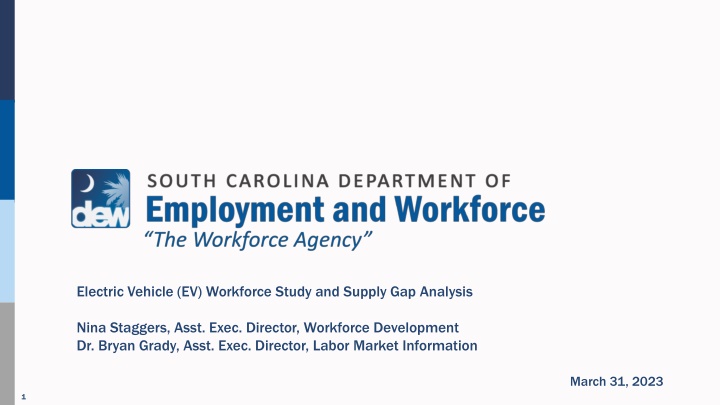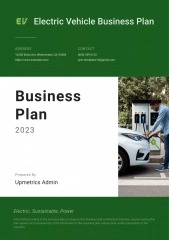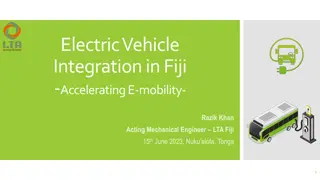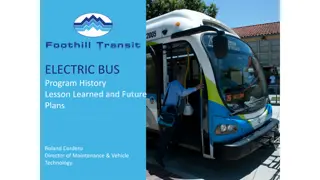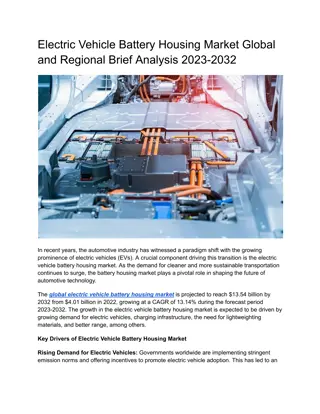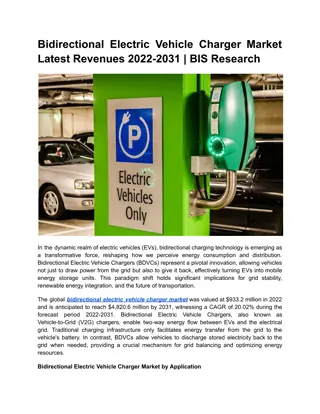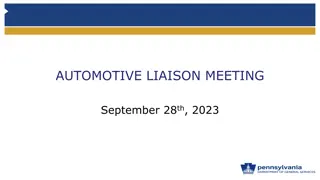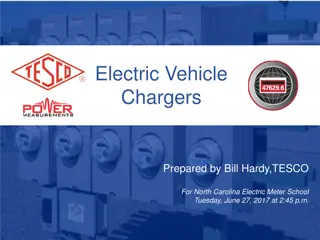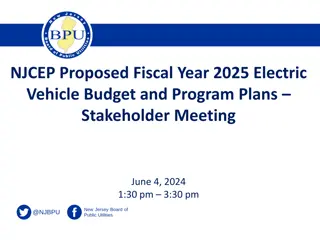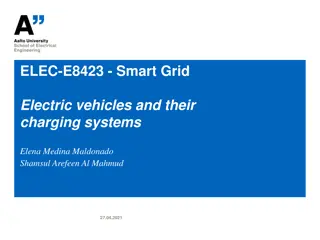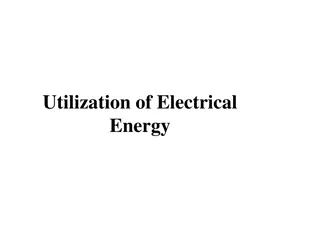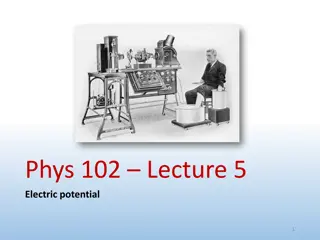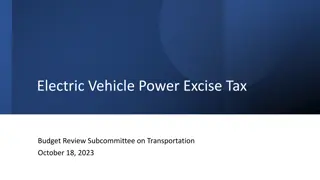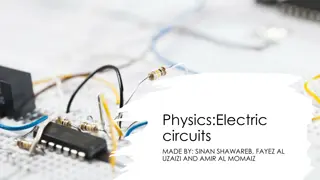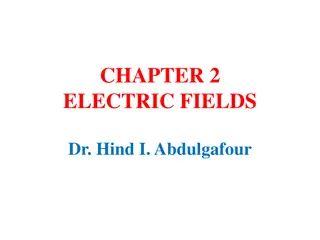Electric Vehicle Workforce Analysis and Industry Insights
This study delves into the Electric Vehicle (EV) industry's workforce landscape, addressing gaps in supply and demand. It examines areas like vehicle and battery manufacturing, service work, and infrastructure. The data presented sheds light on current employment figures and future trends, offering recommendations for workforce development strategies.
Download Presentation

Please find below an Image/Link to download the presentation.
The content on the website is provided AS IS for your information and personal use only. It may not be sold, licensed, or shared on other websites without obtaining consent from the author.If you encounter any issues during the download, it is possible that the publisher has removed the file from their server.
You are allowed to download the files provided on this website for personal or commercial use, subject to the condition that they are used lawfully. All files are the property of their respective owners.
The content on the website is provided AS IS for your information and personal use only. It may not be sold, licensed, or shared on other websites without obtaining consent from the author.
E N D
Presentation Transcript
Electric Vehicle (EV) Workforce Study and Supply Gap Analysis Nina Staggers, Asst. Exec. Director, Workforce Development Dr. Bryan Grady, Asst. Exec. Director, Labor Market Information March 31, 2023 1 1
Background on Executive Order 2022-31 Three DEW requirements: Evaluate the state s existing and anticipate EV-related workforce availability and capacity needs. Conduct a comprehensive and detailed supply-gap analysis of the EV ecosystem, in consultation with the business community, industry in consultation with the business community, industry stakeholders, education providers, and other state agencies and stakeholders, education providers, and other state agencies and departments. departments. Identify and report any recommended statutory or regulatory changes or enhancements related to the state s existing workforce development. 2 2
Todays Goals Present findings of EV workforce study Industry scope Primary EV occupations Current openings Program completions Gaps in demand/supply Workforce availability Recommended workforce development strategies Obtain input on the results 3 3
Defining the Industry There is no standard definition of the EV industry. As such, there is limited data available. EV data is intermixed with other traditional sectors. In general, the EV workforce is likely to engage in four areas: 1. Vehicle manufacturing 2. Battery manufacturing 3. Service/maintenance work 4. Infrastructure Charging stations Utility work associated with increased electricity demand 4 4
SC Private Employment by EV-Related Industry Motor Vehicle Motor Vehicle Manufacturing Manufacturing (NAICS 3361) (NAICS 3361) Battery Battery Manufacturing Manufacturing (33591) (33591) Automotive Automotive Elec. Repair Elec. Repair (811118) (811118) Infrastructure Infrastructure (335999 & (335999 & 221122) 221122) Total Total 2011 Annual 4,784 805 482 2,819 8,890+ 2019 Annual 12,845 1,151 604 3,338 17,938+ 2020 Annual 12,883 908 530 3,394 17,715+ 2021 Annual 12,783 957 532 3,472 17,744+ Note: EV activity is contained within these sectors. For example, production of Volvo and BMW internal combustion engine (ICE) vehicles currently appears in Vehicle Manufacturing. There is currently no way to differentiate EV and ICE in the Bureau of Labor Statistics (BLS) data. Similarly, 33591 contains all Battery Manufacturing employment, which could include plants making batteries for non-EV purposes. Source: Quarterly Census of Employment and Wages. 2021 data are preliminary. Lightcast data used when QCEW records are suppressed. 5 5 5
SC Private Employment Compensation Average Annual Pay Average Annual Pay Industry Industry 2011 2019 2020 2021 Motor vehicle manufacturing $73,064 $71,455 $66,288 $72,378 Battery manufacturing $71,208 $84,630 $82,395 $89,930 Automotive electrical repair $28,977 $40,904 $39,959 $44,119 Infrastructure $59,190 N/A $78,775 $81,297 Total, all private industries $37,734 $45,694 $49,022 $51,844 Source: Quarterly Census of Employment and Wages. 2021 data are preliminary. Lightcast data used when QCEW records are suppressed. 6 6 6
Labor Demand by Occupation What positions have existing EV-related facilities in other states been hiring for over the last 12 months? SOC SOC Description Description Job Openings Job Openings 551 523 504 450 401 270 247 234 15-1299 15-1252 17-3029 49-9071 49-3023 17-2112 17-2071 17-2041 Computer Occupations, All Other Software Developers Engineering Technicians, Except Drafters, All Other Maintenance and Repair Workers, General Automotive Service Technicians and Mechanics Industrial Engineers Electrical Engineers Chemical Engineers Source: Lightcast/Help Wanted OnLine job posting data for Tesla (CA, NV, and TX); Lucid (AZ); and Rivian (IL) 7 7 7
Skills Required: EV Job Posting Characteristics Minimum Education Requirements Most Common Programs of Study Requirements Program of Study Program of Study Postings Postings Educational Degree Educational Degree Postings Postings Engineering, General 2,100 High School Diploma Mechanical Engineering Electrical And Electronics Engineering Computer Science Business Administration And Management, General Logistics, Materials, And Supply Chain Management 1,643 1,713 Associate s Degree 424 1,349 Bachelor s Degree 5,762 984 Master s Degree 125 734 Doctoral Degree 60 379 Source: Lightcast/Help Wanted OnLine job posting data for Tesla (CA, NV, and TX); Lucid (AZ); and Rivian (IL) 8 8 8
EV Supply Gap Analysis for Occupations Requiring a Postsecondary Credential Current SC Current SC Employment Employment Median Wage Median Wage (Hourly) (Hourly) Program Program Completions Completions Occupation Occupation SOC SOC Entry Education Entry Education Job Openings Job Openings Supply Gap Supply Gap Design and Development Design and Development Chemical Engineers Computer Occupations, All Other Electrical Engineers Engineering Technologists and Technicians, Except Drafters, All Other Industrial Engineers Materials Engineers Mechanical Drafters Mechanical Engineers Software Developers Electric Vehicle Maintenance Electric Vehicle Maintenance Automotive Service Technicians and Mechanics Infrastructure Development Infrastructure Development Urban and Regional Planners Manufacturing Manufacturing Electrical and Electronic Engineering Technologists and Technicians Electro-Mechanical and Mechatronics Technologists and Technicians Industrial Engineering Technologists and Technicians Mechanical Engineering Technologists and Technicians Industrial Production Managers Logisticians Scientific Research Scientific Research Chemists Materials Scientists Total Source: Lightcast/EMSI, Job Openings data; National Center of Education Statistics(NCES), Integrated Postsecondary Education Data System (IPEDS), 2021 Completions 17-2041 15-1299 17-2071 Bachelor's Degree Bachelor's Degree Bachelor's Degree 394 2,708 2,116 $42.05 $47.62 $40.70 31 16 (15) 308 (134) 297 197 605 63 17-3029 Associate Degree 978 $34.52 109 24 (85) 17-2112 17-2131 17-3013 17-2141 15-1252 Bachelor's Degree Bachelor's Degree Associate Degree Bachelor's Degree Bachelor's Degree 6,671 677 644 5,491 8,420 $41.72 $38.09 $28.06 $39.66 $47.05 622 53 72 448 1,147 149 (473) (50) 3 85 13 257 308 (191) (839) 49-3023 Postsec. Non-Degree 10,333 $17.69 1,115 298 (817) 19-3051 Master's Degree 394 $28.47 39 6 (33) 17-3023 Associate Degree 1,663 $29.47 215 154 (61) 17-3024 Associate Degree 136 $27.03 17 574 557 17-3026 17-3027 11-3051 13-1081 Associate Degree Associate Degree Bachelor's Degree Bachelor's Degree 1,751 704 3,327 3,379 $24.99 $29.47 $53.30 $33.69 219 105 310 438 43 19 (176) (86) (108) (346) 202 92 19-2031 19-2032 Bachelor's Degree Bachelor's Degree 1,470 $29.98 $44.01 175 <10 5,609 19 (156) 26 0 Insufficient data 51,282 2,916 (2,693) 9 9 9
Entry Level Occupations Electric Vehicle Labor Demand Analysis 2021 Job Openings (Demand) Occupation Entry Education The EV industry includes occupations that do not require a post-secondary credential or degree. Infrastructure Development Electrical Power-Line Installers and Repairers Electricians Manufacturing Computer Numerically Controlled Tool Operators Electrical, Electronic, and Electromechanical Assemblers, Except Coil Winders, Tapers, and Finishers Engine and Other Machine Assemblers Inspectors, Testers, Sorters, Samplers, and Weighers Laborers and Freight, Stock, and Material Movers, Hand Machinists Maintenance and Repair Workers, General Structural Metal Fabricators and Fitters Miscellaneous Assemblers and Fabricators Transportation Inspectors Total Source: Lightcast, Job Openings data High School Diploma High School Diploma 287 1,077 High School Diploma 274 Employers may provide employer-specific training or on the job training to prepare individuals for employment in these occupations. 691 High School Diploma High School Diploma High School Diploma No Formal Education High School Diploma High School Diploma High School Diploma High School Diploma High School Diploma 230 1,483 10,392 1,248 2,876 118 4,918 18 23,612 10 10 10
Sources of Employees APPROXIMATE ANNUAL EXIT POPULATION: 108,700 108,700 APPROXIMATE ANNUAL ENTRY POPULATION: 132,500 132,500 Individuals coming through workforce programs (WP, WIOA, etc.) 33,300 Workers retiring 6 HS and College Students seeking employment 1 41,000 7,500 Individuals dying 7 Local Area Unemployment Statistics (February 2023) 2,382,173 Individuals released from prison seeking employment 2 5,000 Individuals going to prison 8 4,400 Employed: 2,306,083 Unemployed: 76,090 Individuals moving to SC & seeking employment 3 86,500 Individuals moving out-of-state 9 63,500 Assumed Static Individuals re-entering the labor force UNKNOWN UNKNOWN Individuals voluntarily leaving labor force UNKNOWN UNKNOWN Individuals residing in SC working elsewhere Individuals residing elsewhere working in SC 121,700 181,100 11 11 All footnotes available upon request.
Conclusions Growth of the EV ecosystem is moving fast! The occupations needed to support the EV ecosystem are a subset of existing industries such as motor vehicle manufacturing, battery manufacturing, charging infrastructure, and auto repair and maintenance. Workforce demand currently outpaces supply in several key occupations. We expect this trend to continue as the industry expands even further. Efforts to build the EV workforce must include strategies targeting multiple populations and address barriers to labor participation. 12 12
Recommendations for Building Workforce Increase awareness of EV occupations Develop clear and comprehensive pathways/tools Promote work-based learning opportunities Expand reentry programs and efforts to reintegrate ex-offenders Invest in upskilling through Incumbent Worker Training Invest in transportation and child care assistance 13 13
USDOL Southeast Region EV Industry Collaborative Aims to coordinate engagement in the region for state and local workforce agencies, educational institutions, partner organizations, and businesses in the electric vehicle sector. Short-term goals: Develop an inventory of the core competencies needed for EV-related occupations Create a consistent narrative or elevator pitch about EV occupations Review policies for consistency across states and to remove barriers to accessing resources 13 13
Discussion Questions 1. Is the list of occupations complete? Are there any missing occupations that need to be added to the list? 2. What additional strategies should the state consider in building an EV workforce? 3. What other stakeholders do we need to engage as we finalize the study and report? 4. What additional information would you like to see included in a final version of the workforce study and supply gap analysis? 15 15
Next Steps Program staff will continue to engage private sector and government partners with expertise and interest in the EV space. The recent agreement with Scout Motors only increases the salience of this topic in ensuring South Carolina has a competitive workforce as the automotive industry transitions to electric vehicles. 14 14
